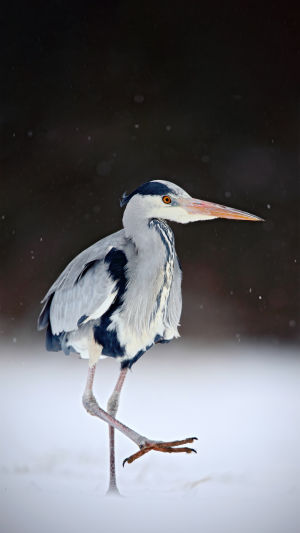The heron is a bird with a very graceful flying posture. Since ancient times, people have admired its elegant appearance. They are also a favorite of many photographers.
On the whole, the heron is mainly gray on the upper body and white on the belly. Adult herons have black eye stripes and crest feathers, and prominent yellow-green legs and bills. They have long legs, long necks and long mouths that people envy. The heron is widely distributed and can be seen in many countries in Eurasia and Africa. Herons have superb flying skills. They are handsome and graceful in shape, with stretched necks, slender lower limbs, and broad wings, and they move like beautiful dancers.
The heron is relatively large in size. The male heron is larger than the female. The male heron is about 75 to 105.2 cm long and weighs about 942 to 1825 grams. Its body color is mainly gray, with a white chest and belly. The heron's iris is yellow, its mouth is yellow, and its feet are tawny or dark brown.
As a wading bird, the heron inhabits the shores and shallow waters of rivers, streams, lakes, ponds, coasts and other waters. They are also found in swamps, rice fields, mountains, forests, and plain deserts in shallow waters and swamps. They will build their nests in trees, and some dry branches and dead grass are their main materials for nesting.
They prey on fish, frogs and some small mammals. When resting, herons mostly stand on one foot. They move together in pairs or groups, sometimes mixed with other species. In spring, herons will soar in the air, chasing each other among individuals, or do some movements in the air, or dive to the ground, which may be to show their "talents" to win the favor of the opposite sex.
Although the heron looks elegant and low-key, in fact its hunting skills are very powerful. Herons will not leave places with water sources such as lakes and ponds, whether they stay on high branches or stand for a long time on land or in dense grass, because there are their favorite food and abundant fish for them to catch. While catching prey, herons can stand motionless in the water for hours until small fish and shrimp come close. At this time, the heron will attack quickly, using its long and sharp beak to pick up the prey in the water, rarely missing. When catching prey such as rabbits and weasels, the heron will specially pick it up and put it into the water until the prey stops moving before swallowing it, and sometimes even catch the crocodile cub. The ferocious side of this prey is in sharp contrast to its cute-looking appearance.
However, although such raptors are not harassed by natural predators, their numbers have been declining. The reason is that their living environment is polluted, and the food they need is no longer sufficient. If their habitat is lost and food is scarce, they will not escape bad luck. In order to protect the heron, humans have included it in the red list of endangered species in the world, hoping that with the efforts of human beings, this bird can fly freely in the blue sky.





